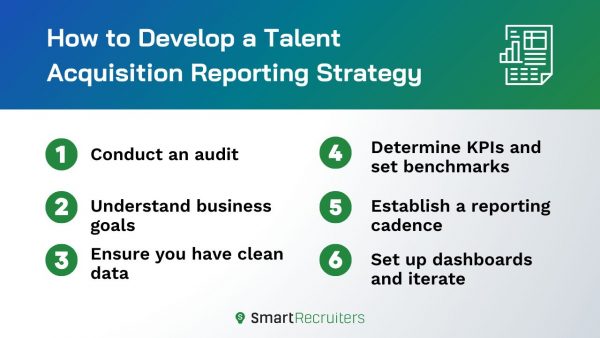Good reporting is critical to achieving hiring success. Without a reporting strategy, how can you know if you are attracting, selecting, and hiring the best talent, within budget, and in the most efficient way? But often, reporting for talent acquisition is harder than it sounds. Gathering reports from disparate systems or business units can take up vast amounts of time, and sometimes a lack of data accuracy prevents the reports from being useful.
Why implement a reporting strategy?
A solid reporting strategy can help you and your organization improve hiring outcomes in multiple ways:
- Evaluate real-time progress against goals
- Uncover hiring process roadblocks
- Measure the progress of DEI recruitment efforts
- Track the effectiveness of new strategies so that you can pivot when necessary
- Align TA with other business functions
- Inform stakeholders across the organization
- Build credibility with executive stakeholders and the C-Suite
- Inform the next steps toward developing a more mature TA function
- Get support for future TA initiatives
- Build effective strategies to stay competitive in the talent marketplace
- Gather career-building win stories
How to build a talent acquisition reporting strategy
Whether you’re still pulling reports manually or have some automation already built into your reporting strategy, you can start afresh and rethink your approach. The goal is to meet the needs of talent acquisition today, which may mean adjusting processes that worked in the past. Here’s how to get started.

1. Conduct an audit
A reporting audit answers these questions.
- What reports are currently being run? At what time intervals?
- Who is responsible for running the reports and distributing them? How much time does it take?
- What reporting tools are available to us? Do we currently leverage our existing dashboards to the fullest?
- Who receives the reports? Are they the right people?
- Who makes decisions based on the reports? How is the success of those decisions being measured?
- Are the current reports effective at measuring what your company needs? Is there information missing that would help with decision-making? Identify the gaps.
2. Understand business goals
An effective reporting strategy takes the business’s needs into account, such as differences across business units, locations, role types, etc. As you develop your strategy, look closely at your TA processes for each business concern. At SmartRecruiters, we encourage our customers to take the Hiring Success Business Assessment. The assessment helps companies define their maturity status across people, processes, and technology in 21 components of talent acquisition. These components are grouped into three buckets: Talent Attraction & Engagement, Collaboration & Selection, and Management & Operating Model.
By looking at the needs of the business against your current hiring practices, you can start to see where accurate reporting will have the most impact as you make improvements.
3. Ensure you have clean data
Talent acquisition systems are designed to deliver good data, but only if they are used properly. Your reporting strategy will be ineffective if data is missing due to poor system adoption or missing links between tools. To ensure accurate data collection, you may need to identify where you need to improve processes or link systems.
4. Determine KPIs and set benchmarks
Every business needs KPIs that matter to the specific situation. While benchmarks may differ across different groups, it’s important to have goals in your sight. Then, individuals can be held accountable for reaching those goals. For example, if hiring velocity is a priority and hiring managers routinely slow down processes by taking too long to make decisions, they should be expected to make the necessary adjustments to hire on time.
5. Establish a reporting cadence
Which reports are run weekly, monthly, quarterly, or annually? Determine who is responsible for creating and reviewing reports. To level-set teams and build the expectation of accountability, schedule meetings to review results well in advance.
Establishing a structured reporting plan may reveal knowledge gaps among stakeholders. To facilitate data literacy, additional training from an expert may be necessary. With greater data literacy, stakeholders can learn to ask better questions of the data and even answer them on their own. Data literacy sets the stage for continuous improvement.
6. Set up dashboards and iterate
Developing a good reporting strategy is an iterative process. The first dashboards may not be as useful as you thought once the data starts coming in. It may take some time to start getting clean data, or some individuals may require education to understand all the data points on the dashboards. Over time, your team will become more fluent in reading the reports and discovering insights that can move the business forward.
Expert tools to uplevel talent acquisition reporting and analytics
Reporting for talent acquisition is a highly specialized function that other business analytics teams may lack the expertise (or bandwidth) to accomplish. Accurate, actionable reporting is essential in your path to hiring success and crucial to unlocking the full potential of your recruiting function.
SmartRecruiters offers a suite of reporting tools and services that bring teams the insights that enable them to hire smarter and faster. It includes:
- SmartAnalytics: Access pre-configured dashboards with advanced filtering capabilities and robust sharing features
- Report Builder: Create automated, personalized recurring reports from built-in templates
- Reporting API: Develop customer reports in your favorite BI tool from any data field in SmartRecruiters
- SmartSuccess Talent Strategy & Insights: Leverage an experienced consultant to develop Tableau dashboards and actionable success plans tailored specifically to your business needs.
Actionable reporting is an essential component of transforming your talent acquisition function. At Colliers EMEA, SmartRecruiters Report Builder was instrumental in making the changes needed to reduce agency spending and improve new hire retention by 25%.
“SmartRecruiters gives us the ability to understand the trends in our recruitment business, diagnose how well things are working, and identify where the opportunities sit. It’s also really intuitive, so you can’t get it wrong”
– Ben Handyside, Director of Talent Acquisition, EMEA, Colliers
If you’re ready to take your reporting strategy to the next level, we’re here to help. Find out more today.







